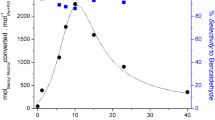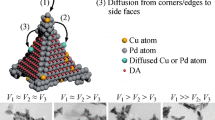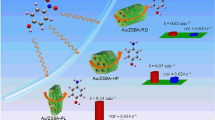Abstract
A major challenge in understanding structure–function relationships in heterogeneous catalysis is bridging the materials complexity gap between the well-ordered surfaces used in fundamental experimental and computational studies and the more complex and dynamic materials that exist under catalytic operating conditions. In this work, we utilized (Ag)Au concave cube nanoparticles as experimental models to test a prediction made by theory regarding a potential bimetallic active site for the dissociation of molecular oxygen, which is a key initiating step in the selective oxygen-assisted coupling of alcohols. As a consequence of their method of synthesis, the concave cubes have surfaces that are rich in Ag-stabilized Au step edges, which is the active site proposed by theory, and thus we predicted that they would have high activity for the methanol coupling reaction. Indeed, in addition to 99% selectivity toward the desired coupling product, methyl formate, the concave cubes show a major increase in activity compared to ozone-activated nanoporous gold, a comparable dilute (Ag)Au alloy catalyst for the same reaction, even without an activating ozone pretreament. Further, the well-defined surfaces of these concave cubes open up opportunities for in-situ microscopy and spectroscopy experiments that can provide a better understanding of (Ag)Au active sites. More broadly, this work highlights how nanoparticles with controlled shapes and well-defined surfaces can be rationally tailored to experimentally validate predictions from theory.





Similar content being viewed by others
References
Xia Y, Xiong Y, Lim B, Skrabalak SE (2009) Shape-controlled synthesis of metal nanocrystals: simple chemistry meets complex physics?. Angew Chem Int Ed 48(1):60–103. doi:10.1002/anie.200802248
Gu J, Zhang Y-W, Tao F (2012) Shape control of bimetallic nanocatalysts through well-designed colloidal chemistry approaches. Chem Soc Rev 41(24):8050–8065. doi:10.1039/C2CS35184F
Ruditskiy A, Peng H-C, Xia Y (2016) Shape-controlled metal nanocrystals for heterogeneous catalysis. Annu Rev Chem Biomol Eng 7(1):327–348. doi:10.1146/annurev-chembioeng-080615-034503
Zhou Z-Y, Tian N, Li J-T, Broadwell I, Sun S-G (2011) Nanomaterials of high surface energy with exceptional properties in catalysis and energy storage. Chem Soc Rev 40(7):4167–4185. doi:10.1039/C0CS00176G
Roldan Cuenya B (2013) Metal nanoparticle catalysts beginning to shape-up. Acc Chem Res 46(8):1682–1691. doi:10.1021/ar300226p
Roldan Cuenya B, Behafarid F (2015) Nanocatalysis: size- and shape-dependent chemisorption and catalytic reactivity. Surf Sci Rep 70(2):135–187. doi:10.1016/j.surfrep.2015.01.001
Bratlie KM, Lee H, Komvopoulos K, Yang P, Somorjai GA (2007) Platinum nanoparticle shape effects on benzene hydrogenation selectivity. Nano Lett 7(10):3097–3101. doi:10.1021/nl0716000
Jiang H-L, Xu Q (2011) Recent progress in synergistic catalysis over heterometallic nanoparticles. J Mater Chem 21(36):13705–13725. doi:10.1039/C1JM12020D
Porosoff MD, Yu W, Chen JG (2013) Challenges and opportunities in correlating bimetallic model surfaces and supported catalysts. J Catal 308:2–10. doi:10.1016/j.jcat.2013.05.009
Norskov JK, Abild-Pedersen F, Studt F, Bligaard T (2011) Density functional theory in surface chemistry and catalysis. Proc Natl Acad Sci USA 108(3):937–943. doi:10.1073/pnas.1006652108
Holewinski A, Xin H, Nikolla E, Linic S (2013) Identifying optimal active sites for heterogeneous catalysis by metal alloys based on molecular descriptors and electronic structure engineering. Curr Opin Chem Eng 2(3):312–319. doi:10.1016/j.coche.2013.04.006
Xin H, Holewinski A, Schweitzer N, Nikolla E, Linic S (2012) Electronic structure engineering in heterogeneous catalysis: Identifying novel alloy catalysts based on rapid screening for materials with desired electronic properties. Top Catal 55(5–6):376–390. doi:10.1007/s11244-012-9794-2
Jacobsen CJH, Dahl S, Clausen BS, Bahn S, Logadottir A, Nørskov JK (2001) Catalyst design by interpolation in the periodic table: Bimetallic ammonia synthesis catalysts. J Am Chem Soc 123(34):8404–8405. doi:10.1021/ja010963d
Hansgen DA, Vlachos DG, Chen JG (2010) Using first principles to predict bimetallic catalysts for the ammonia decomposition reaction. Nat Chem 2(6):484–489. doi:10.1038/nchem.626
Wittstock A, Zielasek V, Biener J, Friend CM, Bäumer M (2010) Nanoporous gold catalysts for selective gas-phase oxidative coupling of methanol at low temperature. Science 327(5963):319–322. doi:10.1126/science.1183591
Kosuda KM, Wittstock A, Friend CM, Baumer M (2012) Oxygen-mediated coupling of alcohols over nanoporous gold catalysts at ambient pressures. Angew Chem Int Ed 51(7):1698–1701. doi:10.1002/anie.201107178
Personick ML, Zugic B, Biener MM, Biener J, Madix RJ, Friend CM (2015) Ozone-activated nanoporous gold: a stable and storable material for catalytic oxidation. ACS Catal 5(7):4237–4241. doi:10.1021/acscatal.5b00330
Biener J, Biener MM, Madix RJ, Friend CM (2015) Nanoporous gold: Understanding the origin of the reactivity of a 21st century catalyst made by pre-Columbian technology. ACS Catal 5(11):6263–6270. doi:10.1021/acscatal.5b01586
Personick ML, Montemore MM, Kaxiras E, Madix RJ, Biener J, Friend CM (2016) Catalyst design for enhanced sustainability through fundamental surface chemistry. Phil Trans R Soc A 374 (2061). doi:10.1098/rsta.2015.0077
Personick ML, Madix RJ, Friend CM (2017) Selective oxygen-assisted reactions of alcohols and amines catalyzed by metallic gold: Paradigms for the design of catalytic processes. ACS Catal 7(2):965–985. doi:10.1021/acscatal.6b02693
Xu B, Haubrich J, Baker TA, Kaxiras E, Friend CM (2011) Theoretical study of O-assisted selective coupling of methanol on Au(111). J Phys Chem C 115(9):3703–3708. doi:10.1021/jp110835w
Zugic B, Wang L, Heine C, Zakharov DN, Lechner BAJ, Stach EA, Biener J, Salmeron M, Madix RJ, Friend CM (2017) Dynamic restructuring drives catalytic activity on nanoporous gold-silver alloy catalysts. Nat Mater 16(5):558–564. doi:10.1038/nmat4824
Montemore MM, Cubuk ED, Klobas JE, Schmid M, Madix RJ, Friend CM, Kaxiras E (2016) Controlling O coverage and stability by alloying Au and Ag. Phys Chem Chem Phys 18(38):26844–26853. doi:10.1039/C6CP05611C
Montemore MM, Madix RJ, Kaxiras E (2016) How does nanoporous gold dissociate molecular oxygen?. J Phys Chem C 120(30):16636–16640. doi:10.1021/acs.jpcc.6b03371
Wang L-C, Personick ML, Karakalos S, Fushimi R, Friend CM, Madix RJ (2016) Active sites for methanol partial oxidation on nanoporous gold catalysts. J Catal 344:778–783. doi:10.1016/j.jcat.2016.08.012
Oviedo OA, Negre CFA, Mariscal MM, Sánchez CG, Leiva EPM (2012) Underpotential deposition on free nanoparticles: its meaning and measurement. Electrochem Commun 16(1):1–5. doi:10.1016/j.elecom.2011.12.013
Oviedo OA, Vélez P, Macagno VA, Leiva EPM (2015) Underpotential deposition: from planar surfaces to nanoparticles. Surf Sci 631:23–34. doi:10.1016/j.susc.2014.08.020
Personick ML, Langille MR, Zhang J, Mirkin CA (2011) Shape control of gold nanoparticles by silver underpotential deposition. Nano Lett 11(8):3394–3398. doi:10.1021/nl201796s
Padmos JD, Personick ML, Tang Q, Duchesne PN, Jiang D, Mirkin CA, Zhang P (2015) The surface structure of silver-coated gold nanocrystals and its influence on shape control. Nat Commun 6:7664. doi:10.1038/ncomms8664
Personick ML, Langille MR, Wu J, Mirkin CA (2013) Synthesis of gold hexagonal bipyramids directed by planar-twinned silver triangular nanoprisms. J Am Chem Soc 135(10):3800–3803. doi:10.1021/ja400794q
Personick ML, Langille MR, Zhang J, Harris N, Schatz GC, Mirkin CA (2011) Synthesis and isolation of {110}-faceted gold bipyramids and rhombic dodecahedra. J Am Chem Soc 133(16):6170–6173. doi:10.1021/ja201826r
Personick ML, Mirkin CA (2013) Making sense of the mayhem behind shape control in the synthesis of gold nanoparticles. J Am Chem Soc 135(49):18238–18247. doi:10.1021/ja408645b
Zhang J, Langille MR, Personick ML, Zhang K, Li S, Mirkin CA (2010) Concave cubic gold nanocrystals with high-index facets. J Am Chem Soc 132(40):14012–14014. doi:10.1021/ja106394k
Liu M, Guyot-Sionnest P (2005) Mechanism of silver(I)-assisted growth of gold nanorods and bipyramids. J Phys Chem B 109(47):22192–22200. doi:10.1021/jp054808n
Xu B, Madix RJ, Friend CM (2010) Achieving optimum selectivity in oxygen assisted alcohol cross-coupling on gold. J Am Chem Soc 132(46):16571–16580. doi:10.1021/ja106706v
Xu B, Liu X, Haubrich J, Madix RJ, Friend CM (2009) Selectivity control in gold-mediated esterification of methanol. Angew Chem Int Ed 48(23):4206–4209. doi:10.1002/anie.200805404
Xu B, Friend CM (2011) Oxidative coupling of alcohols on gold: Insights from experiments and theory. Faraday Discuss 152:307–320. doi:10.1039/c1fd00015b
Stowers KJ, Madix RJ, Friend CM (2013) From model studies on Au(111) to working conditions with unsupported nanoporous gold catalysts: oxygen-assisted coupling reactions. J Catal 308:131–141. doi:10.1016/j.jcat.2013.05.033
Wang L-C, Stowers KJ, Zugic B, Biener MM, Biener J, Friend CM, Madix RJ (2015) Methyl ester synthesis catalyzed by nanoporous gold: from 10–9 Torr to 1 atm. Catal Sci Technol 5(2):1299–1306. doi:10.1039/c4cy01169d
Wang L-C, Stowers KJ, Zugic B, Personick ML, Biener MM, Biener J, Friend CM, Madix RJ (2015) Exploiting basic principles to control the selectivity of the vapor phase catalytic oxidative cross-coupling of primary alcohols over nanoporous gold catalysts. J Catal 329:78–86. doi:10.1016/j.jcat.2015.04.022
Langille MR, Personick ML, Zhang J, Mirkin CA (2012) Defining rules for the shape evolution of gold nanoparticles. J Am Chem Soc 134(35):14542–14554. doi:10.1021/ja305245g
Acknowledgements
Acknowledgment is made to the donors of The American Chemical Society Petroleum Research Fund for partial support of this research. This work was also supported by start-up funding from Wesleyan University. SEM characterization was carried out at Yale University and facilities use was supported by YINQE and NSF MRSEC DMR 1119826. ICP-AES measurements were performed at the Yale Analytical and Stable Isotope Center (YASIC), a Yale Institute for Biospheric Studies (YIBS) research center.
Author information
Authors and Affiliations
Corresponding author
Electronic supplementary material
Below is the link to the electronic supplementary material.
Rights and permissions
About this article
Cite this article
Robertson, D.D., King, M.E. & Personick, M.L. Concave Cubes as Experimental Models of Catalytic Active Sites for the Oxygen-Assisted Coupling of Alcohols by Dilute (Ag)Au Alloys. Top Catal 61, 348–356 (2018). https://doi.org/10.1007/s11244-017-0874-1
Published:
Issue Date:
DOI: https://doi.org/10.1007/s11244-017-0874-1




